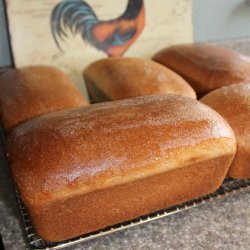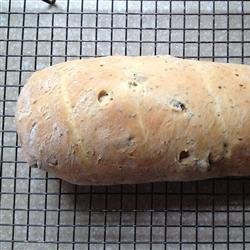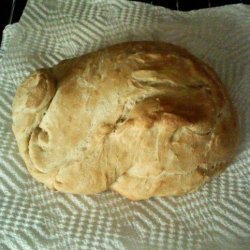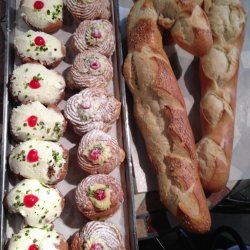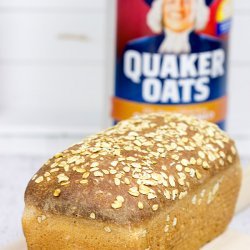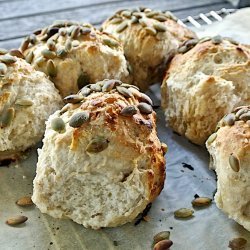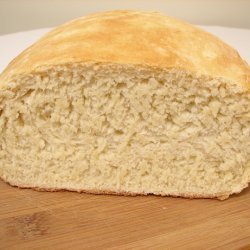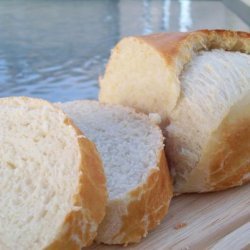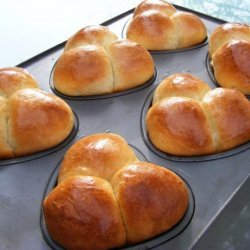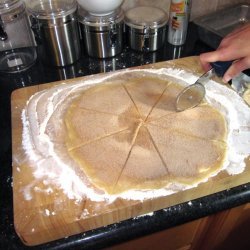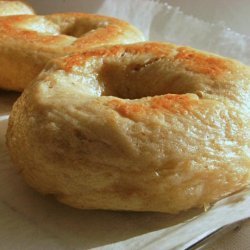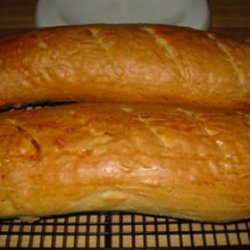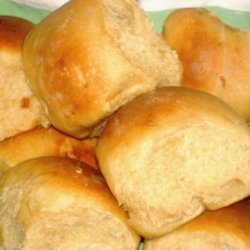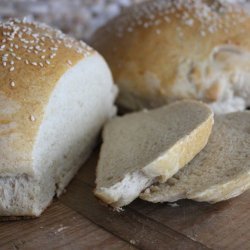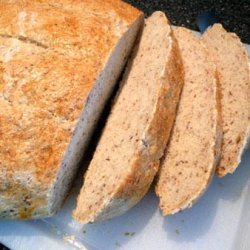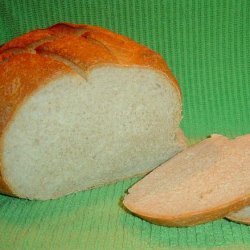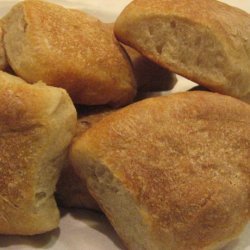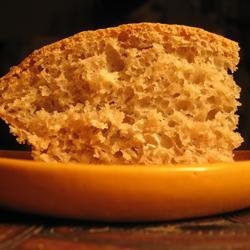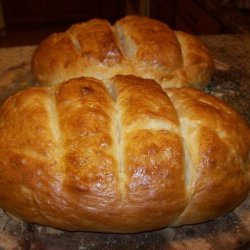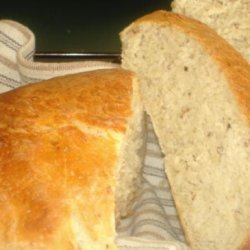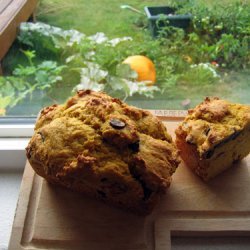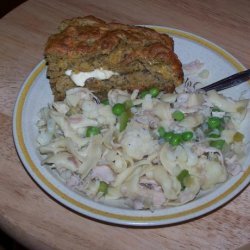Ingredients:
- 1/2 cup lukewarm water
- 2/3 cup lukewarm water
- 2 tbsp lukewarm water
- 3/4 cup additional lukewarm water
Directions:
- Scrap Dough.
- Mixing: On the evening before you plan to bake the bread: In a small glass bowl, mix the yeast in 1/2 c lukewarm water (do the baby's bottle test on your wrist) and make sure that it bubbles (about 10 minutes).
- In a medium size bowl, mix flour, salt and 1/3 c of the yeasted water (reserve the extra for the Poolish).
- Kneading and Fermenting: Without adding extra flour, knead until smooth (about 5 minutes).
- Cover the scrap dough tightly with plastic.
- Leave to ferment at room temperature for about 3 hours, then refrigerate until the next morning.
- Poolish.
- Mixing: On the same evening before you plan to bake the bread: Put the flour in another medium size bowl.
- Add 1 Tbsp of the yeasted water from the Scrap Dough ingredients to 2/3 c lukewarm water and beat.
- This will be quite sloppy.
- Fermenting: Cover the bowl with plastic and ferment in refrigerator until the next morning.
- Actual Dough.
- Mixing: In the morning of the day you plan to bake the bread: In a small glass bowl, mix the yeast in 2 Tbsp lukewarm water (do the baby's bottle test on your wrist) and make sure that it bubbles (about 10 minutes).
- Put the flour in a large bowl.
- Pour the water into the fermented Poolish and stir it around a bit.
- Along with the yeasted water, pour the Poolish water into the large bowl with flour.
- Using a wooden spoon, mix until it is just combined.
- Knead it a few times to combine well.
- Cover with plastic and let it rest (Glezer uses the term autolyse for this) for about 20 minutes.
- Break the scrap dough up into smaller pieces.
- Add it with the salt to the rested dough.
- Turn the dough out of the bowl onto an unfloured work surface.
- Wash and dry the bowl.
- Kneading: Without adding extra flour, knead the dough until it is silky (about 10 minutes).
- Let your dough scraper (a spatula works) be your friend if the dough is sticking to the board.
- The dough should be soft and smooth.
- If it feels too stiff during mixing, add 1 or 2 Tbsp water.
- Proofing: Put the dough in the large bowl (should be large enough to allow the dough to expand by at least 3 times).
- Cover with plastic.
- Let it ferment at warm room temperature for 20 minutes.
- After 20 minutes has passed, lightly sprinkle the work surface with flour.
- Carefully turn the dough out and lightly sprinkle the top of the dough with flour.
- Gently spread the dough out (try not to disturb the bubbles).
- Fold the left side into the center, then the top, then the right side then the bottom.
- Turn the dough over and fold in half once more.
- Place it back in the bowl smooth side up.
- Cover with plastic.
- Let it ferment at room temperature for 20 minutes again.
- Repeat this step twice.
- (This step is done at 20 minutes, 40 minutes, 60 minutes after the first kneading.) After those 20 minute sessions have passed, cover with plastic and let the dough rise undisturbed for about 2 hours until it has doubled and is light and bubbly.
- Shaping: Sprinkle a tiny bit of flour on the work surface.
- Gently turn the dough out, disturbing it as little as possible.
- Lightly sprinkle the top of the dough with flour.
- If you are making two boules, cut the dough in half.
- Gently spread the dough out (try not to disturb the bubbles).
- Fold the left side into the center, then the top, then the right side then the bottom.
- Turn it over.
- Continue to fold it underneath itself to form an even tight ball without actually deflating the dough.
- Place it seam side down on a parchment covered peel.
- Sprinkle generously with flour.
- Cover with plastic wrap and let rise at room temperature for an hour or more- until the dough is about doubled.
- To test, flour your finger and press gently on the edge- it should very slowly spring back.
- For comparison, try pressing early on to see how it quickly springs back when the dough has not risen enough.
- Baking: Thirty minutes before you are going to bake, put the baking stone on the second from the bottom rack.
- Pour water into a broiling pan and place it on the bottom rack of the oven.
- Turn oven to 475°F.
- At the time of baking, spray the top of the boule liberally with water.
- Put the bread in oven and immediately turn the oven down to 425°F.
- Bake the bread on the second lowest rack for 40- 45 minutes or until it is hollow sounding on the bottom.
- Half way through the baking, remove the tray of water and turn the bread around to account for uneven heat in the oven.
- When the bread is done, turn off the oven.
- Put the finished bread back in the oven and leave with the door ajar for 5 or 10 minutes.
- Remove to cool upended on cooling rack.
- Wait til the bread is completely cool before cutting it.
- If you want to eat warm bread, it is advisable to reheat the bread.
- The broiling pan of water in the oven is to create steam at the beginning of the baking time to make very crusty bread.
- Uneaten bread should be stored at room temperature.
- Bread can also be stored in the freezer- double bagged airtight plastic.
- Take it out of the freezer and leave it in the bag until the bread has thawed.
- To reheat the bread, turn the oven to 500 degrees F for 5 minutes or so.
- Turn the oven OFF.
- Put the bread in the oven for ten minutes.
Nutrition Facts
| Amount Per 1 Serving | |||
| Calories | 306.12 Kcal (1282 kJ) | ||
| Calories from fat | 7.79 Kcal | ||
| % Daily Value* | |||
| Total Fat | 0.87g | 1% | |
|---|---|---|---|
| Sodium | 680.11mg | 28% | |
| Potassium | 92.91mg | 2% | |
| Total Carbs | 63.96g | 21% | |
| Dietary Fiber | 2.55g | 10% | |
| Protein | 8.4g | 17% | |
| Iron | 4.3mg | 24% | |
| Calcium | 13mg | 1% | |
| Amount Per 100 g | |||
| Calories | 356.3 Kcal (1492 kJ) | ||
| Calories from fat | 9.06 Kcal | ||
| % Daily Value* | |||
| Total Fat | 1.01g | 1% | |
|---|---|---|---|
| Sodium | 791.59mg | 28% | |
| Potassium | 108.14mg | 2% | |
| Total Carbs | 74.45g | 21% | |
| Dietary Fiber | 2.97g | 10% | |
| Protein | 9.78g | 17% | |
| Iron | 5mg | 24% | |
| Calcium | 15.2mg | 1% | |
* Percent Daily Values are based on a 2000 calorie diet. Your daily values may be higher or lower depending on your calorie needs.
Find out how many calories should you eat.
Get Your Recipe of Health!
Follow RecipeOfHealth on Facebook!


